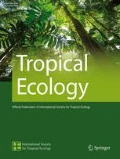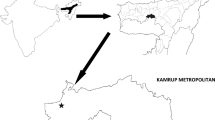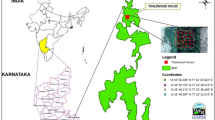Abstract
Shifting agriculture system (locally known as Jhum) is the main driver of deforestation and forest degradation in north eastern region. This system has been extensively practiced to sustain the livelihood in rural areas of Mizoram which possesses serious threats to forest ecosystem and soil fertility. The course of vegetation development in secondary forest in abandoned fallow is a major concern to understand the process of succession in different fallow length. This study was undertaken in Aizawl and Mamit districts, Mizoram with the objectives to determine the tree species diversity, richness and abundance in different fallow periods. Fallow ages of 2–5 years (F5), 6–10 years (F10), 11–20 years (F20) and 21–30 years (F30) were selected with a total number of 37 sites and two circular plots of 12.6 m were laid in each site to carry out extensive enumeration and analysis of tree species. A total number of 91 tree species and 38 families were recorded. The number of trees increased by 47% from F5 to F10 but the same was decreased by 35% from F10 to F30. Ecological indices indicate high diversity and species richness in F10 and F30 compared to F5 and F20. The basal area significantly increased with the length of fallow period. The average girth at breast height (GBH) in F5 was 30 cm but in F30, the GBH increased to 130 cm. The dominant species changed as fallow period increased e.g. F5 was dominated by Castanopsis tribuloides, F10—Rhus chinensis, F20—Macaranga denticulata and F30—Albizia chinensis. The changes in dominant species with respect to fallow ages in the present study could be due to large anthropogenic disturbance on the pioneer species as well as greater establishment ability of the climax species in relation to its environment, altitude and soil condition.






Similar content being viewed by others
References
Choudhury BU, Fiyaz Abdul R, Mohapatra KP, Ngachan SV (2016) Impact of land uses, agro physical variables and altitudinal gradient on soil organic carbon concentration of North-Eastern Himalayan Region of India. Land Degrad Dev 27:1163–1174
Curtis JT (1959) The vegetation of Wisconsin, An ordination of plant communities. University Wisconsin Press, Madison
Curtis JT, McIntosh RP (1950) The interrelations of certain analytic and synthetic phytosociological characters. Ecology 31:434–455
Delang CO, Li WM (2013) Ecological succession on fallowed shifting cultivation fields: a review of the literature. Springer, Heidelberg
Grogan P, Lalnunmawia F, Tripathi SK (2012) Shifting cultivation in steeply sloped regions: a review of management options and research priorities for Mizoram state, northeast India. Agrofor Syst 84(2):163–177
Hauchhum R (2017) Aboveground biomass and carbon stock assessment in forest stands of Gmelina arborea Roxb. in Mizoram North-East India. J Trop For Environ 7(2):37–44
Hauchhum R, Tripathi SK (2017) Rhizosphere effects of Melocanna baccifera on soil microbial properties under different fallow phases following shifting cultivation. Int J Plant Soil Sci 17(1):1–9
Hauchhum R, Tripathi SK (2019) Carbon and nitrogen differences in rhizosphere soil of annual plants in abandoned lands following shifting agriculture in northeast India. Nutr Cycl Agroecosyst 113:157–166
Karthik T, Veeraswami GG, Samal PK (2009) Forest recovery following shifting cultivation: an overview of existing research. Trop Conserv Sci 2:374–387
Kennard DK (2002) Secondary forest succession in a tropical dry forest: patterns of development across a 50-year chronosequence in lowland Bolivia. J Trop Ecol 18(1):53–66
Lawrence D (2004) Erosion of tree diversity during 200 years of shifting cultivation in Bornean rainforest. Ecol Appl 14(6):1855–1869
Mandal D, Sharda VN (2013) Appraisal of soil erosion risk in the Eastern Himalayan Region of India for soil conservation planning. Land Degrad Dev 24(5):430–437
Margalef DR (1958) Information theory in ecology. Yearb Soc Gen Syst Res 3:36–71
Mertz O, Wadley RL, Neilsen U, Bruun TB, Colfer CJP, de Neergard A, Jepsen MR, Martinussen T, Zhao Q, Noweg GT, Magid J (2008) A fresh look at shifting cultivation: fallow length an uncertain indicator of productivity. Agric Syst 96(1–3):75–84
Mukul SA, Herbohn J, Firn J (2016) Tropical secondary forests regenerating after shifting cultivation in the Philippines uplands are important carbon sinks. Sci Rep 6:22483
NRSC (National Remote Sensing Centre) (2011) Wasteland Atlas of India, Department of Land Resources. dolr.nic..in/dolr/wasteland_atlas.asp
Pielou EC (1975) Ecological diversity. Wiley, New York
Punitha P, Ansari MA, Pandey DK, Ram D, Shiv Datt PK, Sharma MA, Jyothi SSP, Prakash N (2018) Shifting cultivation in North East India: social dimension, cross cultural reflection and strategies for improvement. Indian J Agric Sci 88(6):811–819
Rawat RS, Arora G, Rawat J, Rawat VRS, Singson MZ, Ramchhanliana H (2018) Forest carbon stocks of REDD+ project area in Mizoram: baseline report. Indian Council of Forestry Research and Education, Dehradun
Rerkasem K, Lawrence D, Padoch C, Schmidt-Vogt D, Ziegler AD, Bruun TB (2009) Consequences of swidden transitions for crop and fallow biodiversity in Southeast Asia. Hum Ecol 37(3):347–360
Saxena KG, Ramakrishnan PS (1984) Herbaceous vegetation development and weed potential in slash and burn agriculture (jhum) in N.E India. Weed Res 24(2):135–142
Shannon CE, Wiener W (1963) The mathematical theory of communication. University Illinois Press, Urbana
Simpson EH (1949) Measurement of diversity. Nature 163:688
State of Environment Report of Mizoram (2016) Department of Environment, Forest and Climate Change, Government of Mizoram prepared and published by Singh OP, De SK, Cajee L, North Eastern Hill University
Styger E, Rakotondramasy HM, Pfeffer MJ, Fernandes EC, Bates DM (2007) Influence of slash-and-burn farming on fallow succession and land degradation in the rainforest region of Madagascar. Agric Ecosyst Environ 119:257–269
Thong P, Pebam R, Sahoo UK (2016) Recovery pattern of vegetation during succession following slash and burn agriculture in Mizoram, North-East India. J Plant Biol Soil Health 3(2):8
Uhl C (1987) Factors controlling succession following slash-and-burn agriculture in Amazonia. J Ecol 75(2):377–407
Wapongnungsang SH, Tripathi SK (2019) Changes in weed diversity and biomass during crop growth in three ared chronosequence of forest fallows in Muallungthu village, Mizoram. Indian J Ecol 46(1):70–75
Yadav PK (2013) Slash-and-burn agriculture in North-East India. Expert Opin Environ Biol 2:1
Ziegler AD, Bruun TB, Gardiola-Claramonte M, Giambelluca TW, Lawrence D, Nguyen TL (2009) Environmental consequences of the demise in swidden cultivation in montane mainland Southeast Asia: hydrology and geomorphology. Hum Ecol 37(3):361–373
Acknowledgements
Both the authors convey sincere thanks to International Centre for Integrated Mountain Development (ICIMOD), Kathmandu, Nepal and Indian Council of Forestry Research and Education (ICFRE), Dehradun, Uttarakhand for sponsoring REDD+ pilot project in Mizoram under which the present study was enabled. Authors are also thankful to officials of State Forest Department, Mizoram and Village Council authorities for their cooperation and assistance in successful conduct of field works.
Author information
Authors and Affiliations
Corresponding author
Rights and permissions
About this article
Cite this article
Hauchhum, R., Singson, M.Z. Tree species composition and diversity in abandoned Jhum lands of Mizoram, North East India. Trop Ecol 61, 187–195 (2020). https://doi.org/10.1007/s42965-020-00079-5
Received:
Revised:
Accepted:
Published:
Issue Date:
DOI: https://doi.org/10.1007/s42965-020-00079-5




